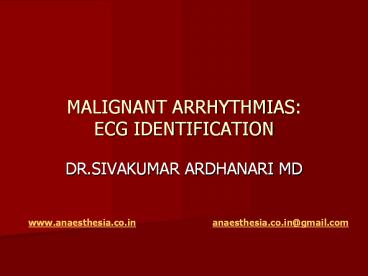MALIGNANT ARRHYTHMIAS: ECG IDENTIFICATION PowerPoint PPT Presentation
1 / 60
Title: MALIGNANT ARRHYTHMIAS: ECG IDENTIFICATION
1
MALIGNANT ARRHYTHMIASECG IDENTIFICATION
- DR.SIVAKUMAR ARDHANARI MD
www.anaesthesia.co.in anaesthesia.co.in_at_gmail.co
m
2
(No Transcript)
3
Normal sinus rhythm
- Impulse formation beginning in the sinus node
- At frequencies between 60 to 100 per minute
- P is always upright in I, II and aVF and inverted
in aVR - Though rhythm is regular, minor variation in PP
interval exists longest and shortest PP differlt
0.16 except in sinus arrhythmia
4
Normal sinus rhythm
- Every P is followed by a QRS complex
- Every QRS is preceded by a P wave
- P and its following QRS is separated by fairly
regular PR interval - TO BE VERY PRECISE P AND QRS ARE IN SIMPLE
HARMONY
5
(No Transcript)
6
NORMAL ECG
7
- When the rhythm deviates from the above said
normalcy it is called ARRHYTHMIA - Broadly it is classified as brady and tachy
arrhythmia - Arrhythmogenesis may be due various causes
8
(No Transcript)
9
- Some arrhythmias are considered MALIGNANT
- Because if not properly and immediately treated,
it can be LETHAL to the sufferer - This is important in understanding the concept of
SUDDEN CARDIAC DEATH
10
(No Transcript)
11
SUDDEN CARDIAC DEATH
12
Anatomy of the conduction system
13
Anatomy of the conduction system
- Sinus node-
- RCA (55-60)
- left circumflex (40-45)artery
- AV node-
- RCA (85-90)
- left circumflex (10-15) artery
14
ACUTE RVMIIWMI
15
Anatomy of conduction system
- The conduction system is densely innervated by
- Cholinergic fibers- parasympathetic
- Adrenergic fibers- sympathetic
- This is important in understanding
- variability of cardiac function with autonomic
influence - effect of parasympathetic stimulation in
terminating arrhythmias
16
BRADYARRHYTHMIAS
- Sinus nodal
- Sinus bradycardia
- Sinus arrhythmia
- Sinus pause/arrest
- Sinoatrial exit block
- Sick sinus syndrome
- AV nodal blocks
- First degree
- Second degree(MOBITZ type 1 and 2)
- Complete heart block
17
SINUS ARREST
18
SICK SINUS SYNDROME
19
ATRIO VENTRICULAR BLOCK
- I degree -conduction time prolonged all
impulses are conducted - II degree -2 forms
- Mobitz type I (WENCKEBACH)- progressive
lengthening of conduction time until an impulse
is failed to be conducted - Mobitz type II- occasional or repetitive sudden
block in conduction without prior measurable
lengthening of conduction time - Complete or III degree -no impulses are conducted
20
FIRST DEGREE AV BLOCK
21
FIRST DEGREE HB
22
IWMIFIRST AV BLOCK
23
21 AV BLOCK
24
COMPLETE AV BLOCK
- Occurs when no atrial activity is conducted to
the ventricles - So atria and ventricles are controlled by
independent pacemakers - One type of complete AV dissociation
- Ventricular focus is usually just below the site
of block - If focus near HIS bundle the rhythm is more stable
25
- CHB can occur at various levels
- AV Node-usually congenital-40-60 bpm
- Bundle of HIS
- Purkinje sys-usually acquired-
26
COMP HEART BLOCK
27
COMP HB
28
CHB
29
CHB
30
IWMICHB
31
APPROACH TO TACHYCARDIA
32
ATRIAL FLUTTER
- F waves rapid regular undulations
- SAW TOOTH APPEARANCE
- Atrial rate250-350 bpm
- Rate regularity of ventricles variable and
depend on AV conduction sequence - QRS may be normal or abnormal as a result of
preexisting intraventricular conduction defect or
aberrancy
33
ATRIAL FLUTTER
34
ATRIAL FLUTTER
35
ATRIAL FLUTTER
36
(No Transcript)
37
SVT VS VT
38
- Differentiating a VT from SVT can be difficult at
times - Golden rule in ER
- ANY WIDE QRS TACHYCARDIA IS VENTRICULAR
TACHYCARDIA UNTIL PROVED OTHERWISE ESPLY WHEN
THE PATIENT HAS A STRUCTURAL HEART DISEASE
39
Diagnosis of VT
- Arises distal to the bifurcation of the HIS
bundle - Diagnosis is by the occurrence of a series of 3
or more consecutive, abnormally shaped PVCs whose
duration exceeds 120 ms, with ST-T vector
pointing opposite the major QRS deflection
40
VENTRICULAR ECTOPICS
41
- RR can be exceedingly regular or can vary
- Atrial activity can be independent of ventricular
activity or can be depolarized retrograde (VA
association)
42
- Fusion beats and capture beats provide the
maximum support for the diagnosis of VT - FUSION BEATS-activation of ventricles from 2 foci
- CAPTURE BEATS- capture of the ventricle by
supraventricular rhythmwith normal confguration
of the captured QRS at intrvl shorter than
tachycardia in question- indicates origin of
impulse is supraventricular
43
FUSION AND CAPTURE BEATS
44
- QRS contours can be
- Unchanging (MONOMORPHIC)
- Vary randomly (POLY OR PLEOMORPHIC)
- Vary repetitively (TORSADES DE PONTES)
- Vary in alternative cplxs (BIDIRECTIONAL)
45
MONOMORPHIC VT
46
POLYMORPHIC VT
47
TORSADES DE POINTES
48
TYPES OF VT
- VT can be
- SUSTAINED- lasting longer than 30 seconds or
requiring termination due to hemodynamic collapse - NON SUSTAINED- stops spontaneously within 30
seconds
49
NON-SUSTAINED VT
50
SUSTAINED VT
51
HYPER ACUTE EXT ALMI
52
DIGITALIS EFFECT
53
PROLONGED QT(U) INTERVAL
54
Ventricular flutter fibrillation
- Represent severe derangement of heart beat that
usually terminate fatally within 3-5 mts if
corrective measures are not undertaken promptly.
55
VENTRICULAR FLUTTER
- Manifested as sine wave in appearance
- Regular large oscillations occurring at a rate of
150-300(usually 200)/min
56
VENTRICULAR FLUTTER
57
VENTRICULAR FIBRILLATION
- Irregular undulations of varying contour
amplitude - Distinct QRS, ST or T are absent
- Fine amplitude fibrillatory waves (0.2mV) with
prolonged VF worse prognosis confused with
asystole
58
VENTRICULAR FIBRILLATION
59
(No Transcript)
60
(No Transcript)

